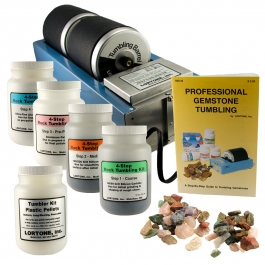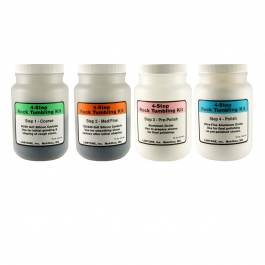- NEW DVD Series – Stone Setting with Bezels
- Tube Set Charm by Kim St. Jean
- Prong Basket Pendant by Kim St. Jean
- NEW DVD Series – Stone Setting with Cold Connections
- New DVD Series – Stone Setting with Wire
- NEW DVD Series: Introduction to Stone Setting by Kim St. Jean
- Featured Tool: Bracelet Bending Plier
- NEW Dvd by Eva Sherman
- Fun, Fast Fold Forming DVD Series
- Double Band Ear Cuff from Alex Simkin
Rock Tumbling 101 Revisited
by Judy Ellis, Wire-Sculpture.com
Wire Jewelry Tip for July 18, 2014
Rock Tumbling 101 Revisited
We are always getting great questions from readers, so today I thought I would re-visit an older post from our blog dealing with a question about Rock Tumbling. Hopefully this will help answer questions you might have about Rock Tumbling.
Question:
I recently bought some small slabs for wiring at a lapidary show that just need some shine put on them. I have a tumbler that I have never used. What do I put in it? Or do I need to polish them some other way?
-Phylliss in Searcy, Arkansas
Answer: (contributed by Dale Armstrong)
To give a complete answer to your question I would need a bit more information such as:
- What style of tumbler do you have, rotary or vibratory?
- How large are the slabs? (Big ones should go into a vibratory tumbler; small ones can be done in a rotary)
- What are the materials? (Rocks need to be separated by hardness to tumble polish, as softer materials can be quickly ground away or beat up by harder materials)
Once you have determined the above answers, here are some suggest on where to start with your Rock Tumbling :
- You will need some grit. Generally silicon carbide, a minimum of 3 grades from coarse to fine, depending on the hardness and material type
- A polishing agent: This will depend on the materials you are tumble polishing, usually cerium oxide works well on most materials.
- A separating medium (I like plastic pellets) to keep the slabs from sticking together for a nice even finish.
To tumble wet:
- This is usually done in a Rotary Tumbler.
- Place the slabs and plastic pellets into the tumbler’s rubber barrel and add enough water to fill it 4/5 of the way.
- Add the grit (coarse first; the amount depends on the size of the barrel).
- Tighten the lid and turn it on for the first run.
- The amount of time required for each run will depend on the hardness of the stones, from a couple of days to weeks.
- When the first run is complete, empty the barrel (never into a sink, as the slurry can really mess up plumbing systems), and thoroughly rinse and clean the pellets and the stones.
- Then repeat the runs, using medium grit next, and finally the fine.
- When you are happy with the results, it is time for the polish.
Be absolutely, positively sure that there is no grit whatsoever left in the barrel or on any of the stones, as one piece could destroy weeks of work! I have barrels just for polish. The polishing run can take less than a day, again depending on the stones. Wash your stones completely, and wrap as desired!
| Lortone Double Barrel Tumbler Kit for Rocks or Wire Jewelry | Lortone 4-Step Abrasive and Polishing Kit |
|---|---|
Using a vibratory tumbler:
I prefer to tumble slabs dry, using the same processes as above without adding any water, as I find slabs tumble polish more quickly in a vibratory tumbler, dry. For an easier solution, you could use a spray protectant, like as an acrylic spray such as Krylon, to give your slabs a nice glossy finish; just be careful not to scratch it when wrapping.
We have a number of supplies available for Rock Tumbling. Warning: Polishing your own stones can be addicting!
Enjoy!
![]()
Do you love this information- why not sign up today for your FREE Jewelry Making Patterns. It’s a great place to start!
Click to Receive Daily Tips by Email





















bobbi helms
July 18, 2014 at 5:46 am
What about opals? I have a smallish rough bolder opal and I have a rotary tumbler. Is it safe to put the opal in there? Or am I risking ruin?
(FYI – I actually have already bezel set this opal and wear it as is. But it definitely could be improved with some more polish/shine.
thanks
beverly
July 18, 2014 at 12:20 pm
I wouldn’t risk any opal in a tumbler or vibrator, it is too soft and would get ruined. Polish with cerium oxide on a felt or leather flat lap. If you are wearing it now then I wouldn’t worry about the polish. Bebeaz
Linda Barton
July 18, 2014 at 7:39 am
You could also join a local Gem and Mineral club. They always have equipment and members who are experts in rock polishing. Using a belt sander for polishing is really instant gratification, but can be a little tricky at first. Use caution! Have fun!!
Donna
July 18, 2014 at 10:24 am
Just a note on tumbling stones. Rotary tumblers are slower but require less attention than vibratory tumblers. Vibratory tumblers will keep the original shape of the stones, rotary tumblers will round the stones more. Vibratory tumblers require most of the stones to be of similiar hardness. Rotary tumblers do not. The beginning of first load usually is stones only, pellets are added as filler in the final stages to maintain volume in the tumbler. You will have shinier stones if you run a soap cycle (1 day for rotary tumbler, a couple hours for a vibratory tumbler: I use a tsp. laundry soap) between each grit change. You will be surprised how grey the water is even after you pre-wash the stones.